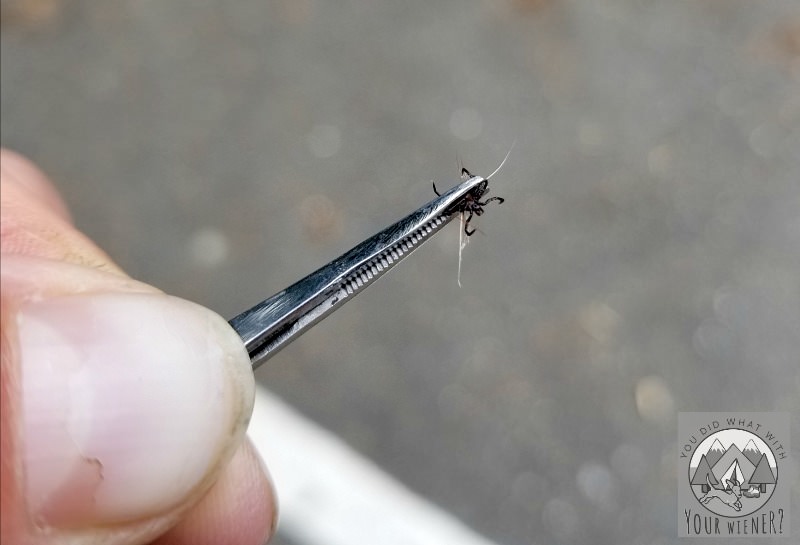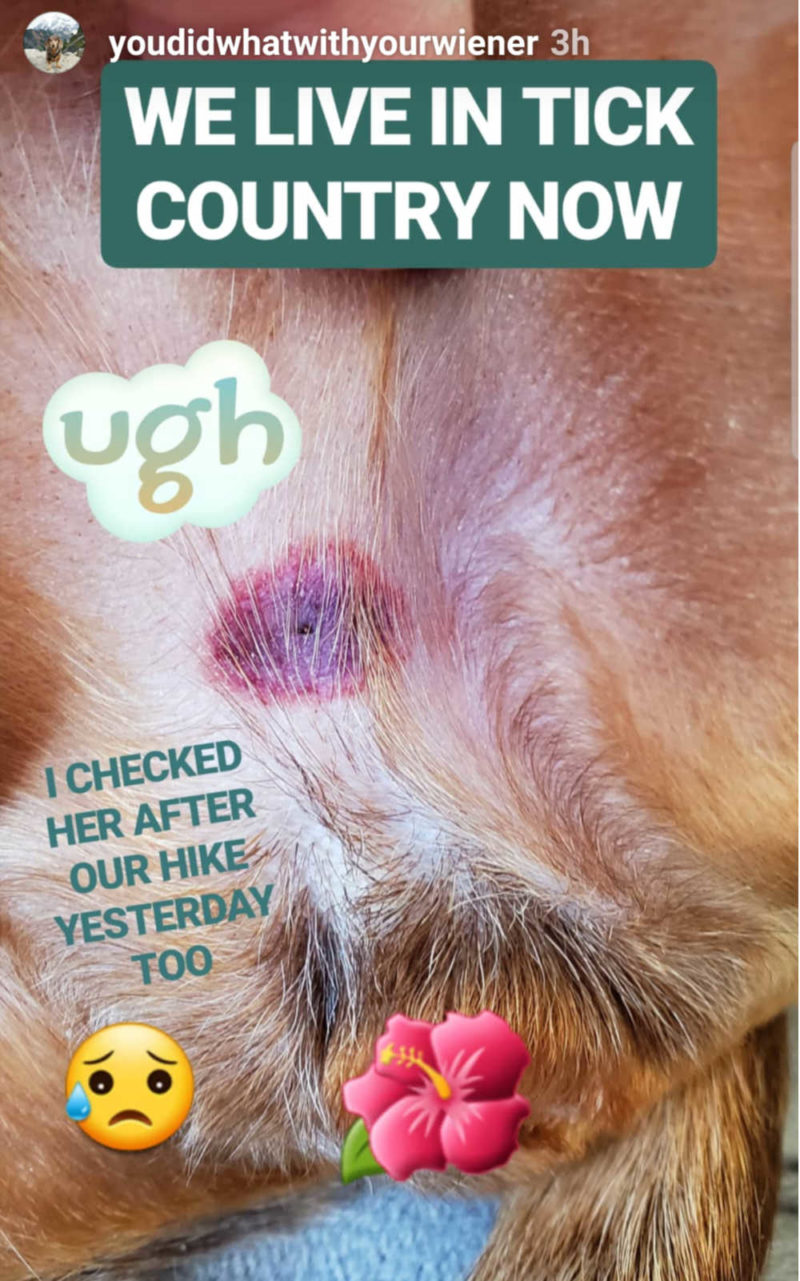The Head of a Tick Was Left In My Dog – This is what Happened
My dog Gretel got bit by a tick.
Despite my best efforts, the tick broke when I tried to remove it, which left a tick head embedded in my dog’s skin.
If this has happened to you, and you’re like me, you started to freak out.
But don’t worry too much yet. It’s not always a terrible thing,
The first time I pulled a tick out of my dog and the head stayed in, this is what happened.
Discovering A Tick Had Bit My Dog
We had been on a hike through grass the day before. I checked my dog for ticks after but I didn’t see any.
We recently moved from Seattle east of the Cascade Mountains where ticks are common so she could have possibly picked it up in the yard too.
I was rubbing her belly when I saw the dark red and purple, circular rash.
It was about the size of a pea – bigger than a pencil eraser but smaller than a dime.
Removing the Tick From My Dog
Of course, in hopes of avoiding Lyme Disease or other illnesses, I wanted to remove the tick right away.
There are many explanations and videos online about how to properly remove a tick from your dog so won’t waste your time describing how.
However, this simple video sums it up really well so watch it if you haven’t already learned how to safely remove a tick from your dog.
I gathered my tick removal kit – my TickEase tick puller (affiliate link) and alcohol swabs – and prepared to get that little bugger out.
I used an alcohol swab to sterilize the tweezers and the area around the tick bite on Gretel.
The problem with all of the information I found online is that all of the ticks that were being removed were already engorged.
An engorged tick seems way easier to grab onto with tweezers than one that isn’t.
This nasty bug hadn’t sucked much blood yet so it was still small and hard to see.
I grabbed the base of the tick, as close to the skin as I could, with the tweezers and pulled firmly and steadily.
The tick was really stuck in there and lifted up her skin quite a bit as I pulled. Suddenly, the body of the tick tore apart.
There was still part of the tick left to grab onto so I tried again.

I pinched the skin and pushed the end of the pointy tweezers in there a little bit to grab ahold of it and just couldn’t seem to. The head was still buried in her skin.
I tried not to panic but I thought, “Well, crap. What am I supposed to do now?”
If we were still lived in the city, I would have called the vet right away and taken her in. They were less than 10 minutes from our house.
However, we don’t have that luxury here. We live in a much smaller, and rural, town now.
There is only one vet office in town. We haven’t become a client of theirs yet and they aren’t open on weekends. The nearest ER vet is 30 minutes away.
So what did I do?
I did what any self-respecting dog owner with limited options would do – I took to the internet to find answers.
How do you Remove a Tick Head That Gets Stuck in Your Dog’s Skin?
I read through several articles explaining how to remove a tick head if it is stuck in your dog.
I found these instructions:
“With your thumb and forefinger pinch up the fold of skin with the embedded tick head.
Using a scalpel or a sterilized single razor blade, carefully scrape the skin containing the head and mouth of the tick, or use a sterilized needle to break the skin and remove the head and mouth.”
One article I read said to use the sharp edge of a credit card to try and dislodge the tick head from the skin.
I tried pinching up the extra skin so I could see the head part embedded in there better. I could see it alright. I could FEEL it.
However, gently scraping the surface of the skin with a credit card, trying to catch the edge and pull it out didn’t work.

The next step was trying razor blade? Uh. No. I’m not using anything that sharp near my wiggly dog.
The articles I read warned about trying too remove the remaining tick body parts many times and irritating it more so I didn’t want to push it.
The Mt. Ascutney Hospital and Health Center actually recommends not trying to remove the embedded tick head at all.
“Do not attempt to remove the mouthparts if they are left in the skin after tick removal… The mouthparts will come out over time naturally.
Trying to remove these mouthparts can cause more trauma and may cause a local skin infection.”
I was still wary of leaving the broken tick head in my dog but it seemed the risk of leaving it alone to do it’s thing may outweigh continuing to pick at it.
Can a Dog Get Lyme Disease from a Tick Head?
You may be worried about Lyme Disease and wondering if your dog can still get it if a tick head is left in their body.
Well, if you’ve removed the body of the tick, the biggest risk is behind you. Removing the body will kill the tick.
Embedded tick mouthparts do not transmit diseases, like Lyme Disease (source), and there is no longer a risk of tick paralysis.
According to the site Tick Encounter, in response to a woman writing in about the tick head being left in with concerns that the tick could still transmit disease:
“This is something that concerns many people but it is just not possible for ticks to
1) continue living once they have been ripped in two; and
2) for them to embed any more than their mouthpart (hypostome) into your skin.
The little red mark you mention is just inflammation around the tick mouth part that remains.”
However, there is now a foreign body stuck in your dog’s skin and that can cause an infection.
It doesn’t hurt to rub the area with al alcohol swab to sterilize it as much as you can but otherwise just monitor the area for a few days to make sure an infection isn’t developing.
If the head of a tick rips off and stays embedded in your dog’s skin, it can no longer transmit Lyme Disease.
If you are at all concerned with how the area around the tick head starts to look – for example, if it is red and swollen – then take your dog to the vet to get it checked out.
Will A Tick Head Eventually Come Out On It’s Own?
The short answer is, yes, a broken-off tick head embedded in the skin will almost always work it’s way out on it’s own over time.
According to Mary M. Gottesman, Ph.D., RN, CPNP, FAAN of The Ohio State University:
“If a tick’s mouthparts remain after the tick has been removed, you have two options.
You can either wait for the mouthparts to work their way out of the skin naturally while keeping the area disinfected, or you can remove them with a clean needle in the same way you would remove a splinter.” (source)
The same Tick Encounter website mentioned above confirms that you don’t have to do anything:
“Eventually this will be pushed out much like a splinter would be.”
So What Did I Do About the Tick Head Embedded in My Dog?
I felt fairly reassured, given the amount of times it was said that leaving the tick head in could be ok, and the expertise/authority of the websites saying it, that I was pretty safe just leaving the tick head alone.
In fact, it sounded like I could make matters worse if I kept trying to dig at it.
Gretel’s tick bite rash, although dark blue and red, was small and seemed typical.
I watched it over the next week and the red spot around the embedded tick head faded.
Eventually, the tick head did come out on it’s own. If I remember right, it only took a week or two.
Like me, you may panicked if you find a tick that has bitten your dog and in a hurry to remove it. I recommend taking your time though.
In hindsight, and next time, I will be sure to pull the skin tighter before I try to pull the tick out. Those suckers are in there tight and and definitely pull on the skin.
I’ll also slow down. I was kind of in a hurry to get it out.
Perhaps I should have taken more care to ensure I was looking the tick in a good light and I could push the tweezers as close to the skin as I could.
I also learned that, if a tick is not engorged, it may be easier to pull the tick out with your fingers by grabbing it as close to the head as possible.
I am positive this is not the last time this will happen to Gretel but hopefully I’ll get better and better at removing ticks while keeping the head intact.
I hope this article has helped ease your mind and convinced you that there is no need to panic of the head of a tick is left in your dog’s skin.


About the Author
Hi, I’m Jessica. I’ve been studying the Dachshund breed since 2007, owned 3 of my own, and shared in the lives of thousands of others through their owner’s stories. When I’m not sharing what I know on this blog, you can find me hiking, camping, and traveling with my adventurous wiener dogs.


Hi thank you so much! I am very scared because I pulled off a deer tick, and the spot is still purple and red , and it’s been 2 days. How long did it take for your baby’s spot to go away?
Hi Grace. I think it took 3 or 4 days for the red spot to go away. The most important thing is if it starts to look inflamed, infected, or the outer edge of the spot change significantly (gets bigger).
Omg Grace you don’t know how much comfort I got reading your post. Thank you so much. Crossing fingers my mini schnauzer’s tick head gets off soon and no infection.
What the hell kind of overcomplicated and dangerous BS is this. Get the little L-shaped plastic simple tool made to remove ticks by turning a few times and NO HEADS BROKEN. Why tf would you start shaving, and tearing with a tweezer. Wake up
There is no need for an aggressive and rude comment. I almost delted it because I only allow respectiful debate on my blog but I think it’s important for others to know that, despite there being several “tick twisting” tools on the market, twisting a tick to remove it is actually not recommended and can also result in a head breaking off and being left in a dog.
Ok, we were out in the boondocks. Not use to tics. Didn’t even know there was a tic removing tool! Thank you for sharing all this information. Very comforting.
Does anyone know of an ointment or something topical that can help the remaining part to dislodge?
Jo Joelle. My concern with this is trying to get it out may cause more irritation and risk of infection than just leaving it to work itself out. I suppose you could try putting Vaselline or something like that on it and massaging the skin in the area to see if you can get it out. I’d be sure to wipe it down well with alcohol after though.
Thank you for writing this! I found it during my own frantic Google search. I’d already read a couple of pet health articles but the name made me laugh so I had to click. I will keep an eye on her (cat, not sausage, but still quite wiggly) neck and not panic. 🙂
I hope all turns out well Elizabeth.
Thank you for this blog. I thought I got the whole tick off, it was dead and not engorged when I pulled it out, but now there’s a hard bump and no dark spot. Does this sound unusual? It’s been a couple weeks and not going away. Any comments on this?
Hi Jackie. I would have a vet look at it. The concerning things to me are that it’s a hard bump and that it’s not going away. It may be nothing but it’s better safe than sorry.
thank you! very helpful and relieves my concern!
Engorged tick. Already fed. Tick will fall off on it’s own in 3 days when full.
You shouldn’t leave a tick in for 3 days to become engorged though because that is sufficient time to transfer lyme disease to your dog.
If you think the tick was hard to remove, how are you going to remove the hibiscus?
I was like, what?? I’m a little slow sometimes 😉 Ha, ha. It’s just a temporary “privacy screen”.
Thank you, exactly what I needed to know!